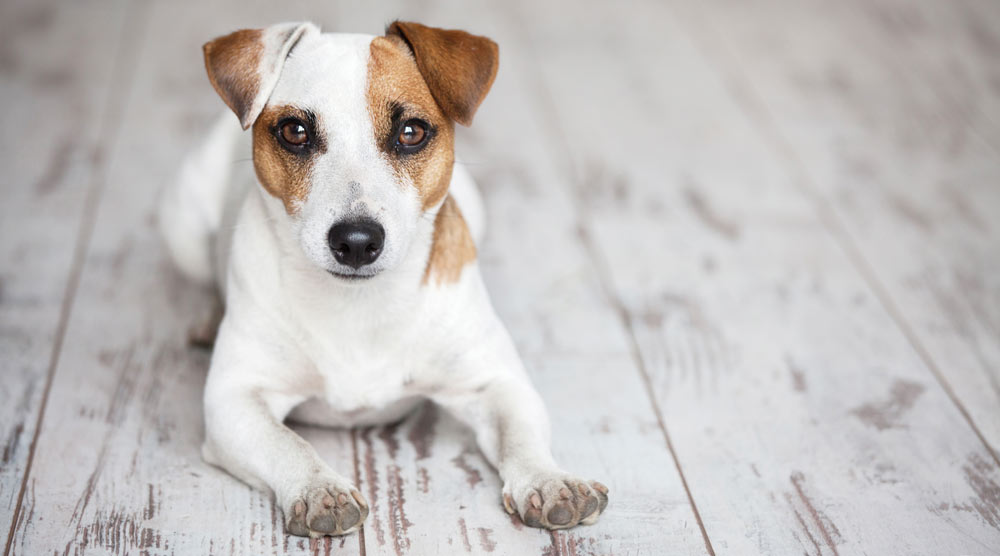Quick Answer
There are many natural techniques you can use to get rid of the dog smell in the house. Here’s a quick list of our favorites – scroll down for detailed instructions for each!
- Air out your home to dissipate mild odors
- Wash your dog’s bedding regularly
- Clean dog toys
- Vacuum carpets twice each week
- Mop hard floors
- Freshen up odorous carpet patches with baking soda
- Keep your dog’s crate clean
- Eliminate accidents with enzymatic cleaners
- Purchase an air purifier
- Steam clean carpets to kill bacteria
- Clean your walls
- Shampoo your carpets once a year
- Groom your dog regularly
- Add apple cider vinegar to your laundry
- Keep your vacuum’s filters clear and clean
Regular cleaning is essential if you want to keep dog odors at bay. It’s not just how often you clean that makes the difference though – it’s also where and how you clean your home.
The good news is that there are plenty of simple methods you can use to get rid of dog smells. Here are 15 fast and easy ways to get rid of a dog smell in the house.
Contents
- Quick Answer
- 15 Home Remedies For Getting Rid of a Dog Smell in the House Fast
- 1. Air Out Your Home
- 2. Wash Dog Bedding Regularly
- 3. Clean Your Dog’s Toys
- 4. Vacuum Carpets (At Least) Twice a Week With a Pet Vacuum
- 5. Vacuum and Mop Hard Floors
- 6. Naturally Freshen Up Odorous Carpet Patches With Baking Soda
- 7. Thoroughly Clean Your Pet’s Crate
- 8. Eliminate Accidents With Enzymatic Carpet Cleaners
- 9. Buy an Air Purifier
- 10. Steam Clean Carpets to Kill Bacteria and Remove Stubborn Odors
- 11. Don’t Forget About Walls
- 12. Shampoo Your Carpet Once A Year
- 13. Groom Your Dog Regularly
- 14. Add Apple Cider Vinegar to Your Laundry
- 15. Regularly Clean Your Vacuum’s Filters
- What Causes a “Doggie” Smell in a House?
- Frequently Asked Questions
- Summary
15 Home Remedies For Getting Rid of a Dog Smell in the House Fast
Regular cleaning is the best way to get the dog smell out of your house. It’s important to clean everywhere your dog goes, even if there’s no visible soiling, as dogs continuously shed hair, dander, and oils.
1. Air Out Your Home
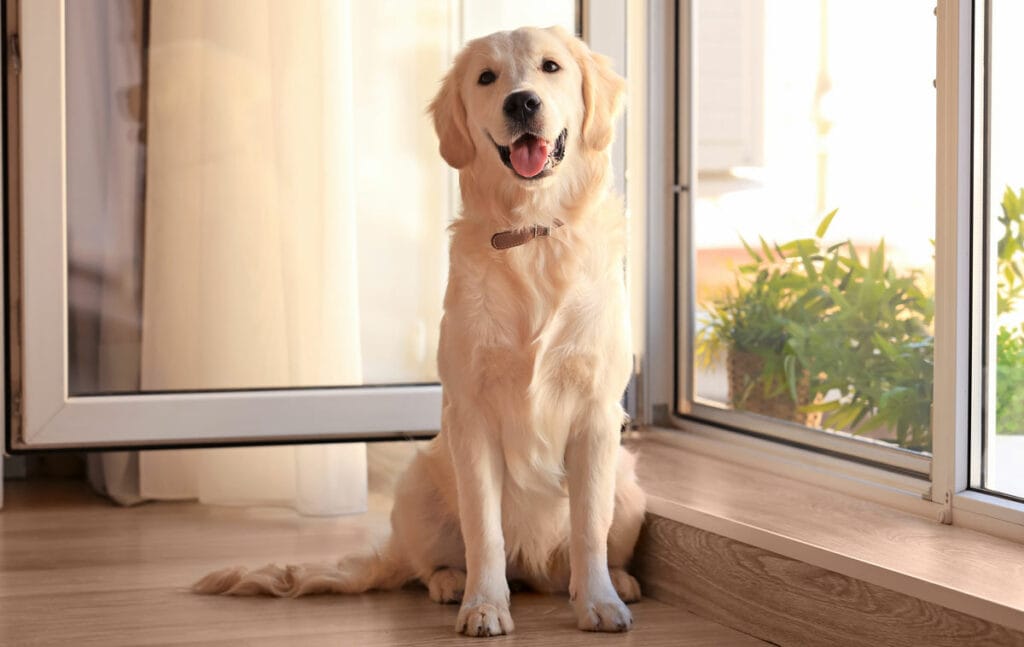
It’s amazing how much of a difference simply opening the windows in your home can make to the odors inside. This is especially true if you live in a house with lots of family members, poor ventilation, or in a humid climate.
Circulating fresher air isn’t only good for our lungs and cognitive functions, but it can also help to dissipate general doggy odors. Opening the windows in more than one room will help to circulate the air more effectively.
Admittedly, this isn’t going to be a magic cure. For deeply embedded odors, you’ll need to take more proactive measures. But, when the weather is mild enough, this can be enough to give the house a pleasant freshen-up.
2. Wash Dog Bedding Regularly
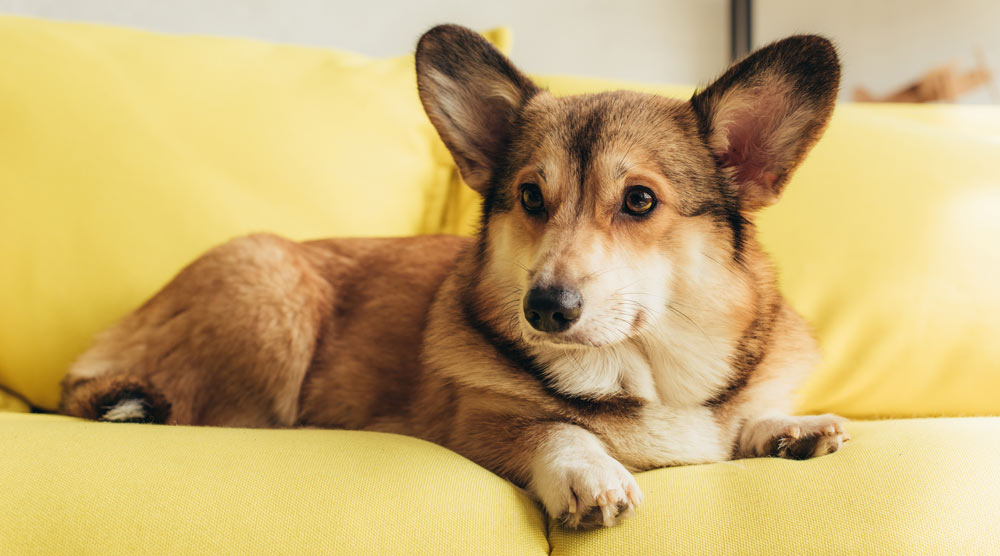
A dog’s bed is often the strongest source of doggie odors. This isn’t surprising, as beds are constantly exposed to hair, dander, oils, and even urine. When combined with a damp post-walk dog, beds become the perfect environment for bacteria and mold.
For this reason, it’s a good idea to wash your dog’s bed at least once every two weeks. If your dog sheds a lot, goes on muddy walks, or is highly active, then you may want to wash the bed weekly.
Soft beds tend to absorb odors faster than other types. Many have foam mattresses that can’t easily be cleaned, so it’s vital that these are protected. Look for soft beds with durable and waterproof covers that can be machine-washed, as this makes it easier to keep the bed clean.
Raised beds are less likely to absorb odors. They can be hosed down in the garden and don’t hold onto moisture. However, not all dogs enjoy this rigid bed style, and you’ll still need to provide a soft blanket that must be washed.
If your dog is an excessive shedder, you may want to hoover the bed first to remove any excess hairs. Alternatively, you could pop it in a mesh bag to prevent it from clogging up the filter in your washing machine.
For dogs that like to sleep on your bed or the sofa, make sure you cover it with a blanket that can be popped in the wash every week.
3. Clean Your Dog’s Toys
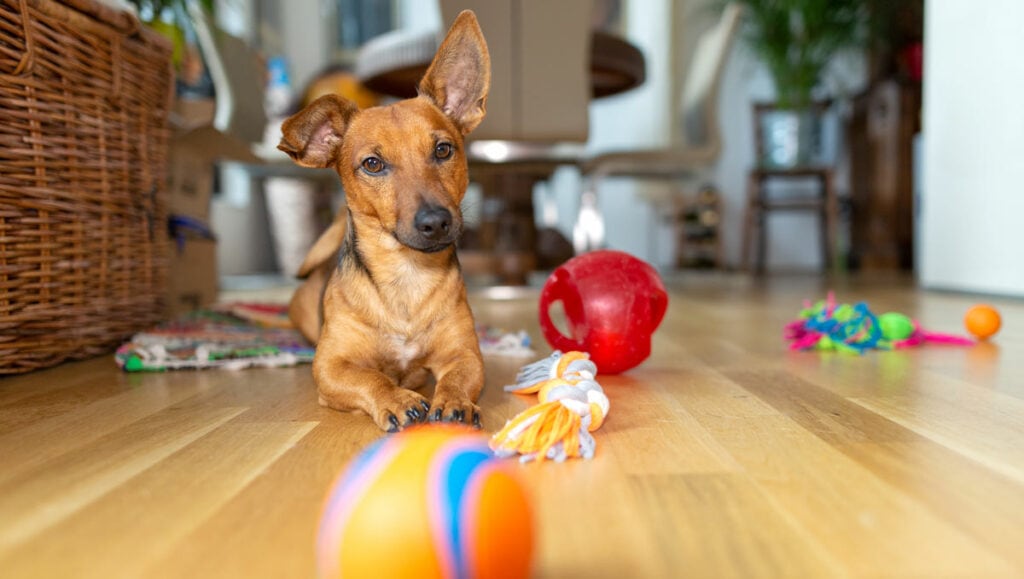
A 2011 study found that pet toys are among the top 10 dirtiest things in the average household.
Saliva, food and general muck can build up on dog toys over time. As well as being a reservoir for pungent odors, the resulting bacteria can be a health hazard.
Getting into the habit of cleaning toys each week is recommended. Hard toys can be cleaned with hot soapy water or a white distilled vinegar solution, before being thoroughly rinsed. Soft toys can usually be machine-washed, and you can add a little baking soda to absorb stinky odors.
Make sure the toys are dry before being stuffed in a toy box. If they’re stored when damp, mold may start to form.
Note: Dog bowls are even dirtier than toys, so make sure you clean them regularly. Drinking or eating from a bowl filled with bacteria could cause your dog to suffer from acne around the mouth and lead to stomach upsets.
4. Vacuum Carpets (At Least) Twice a Week With a Pet Vacuum
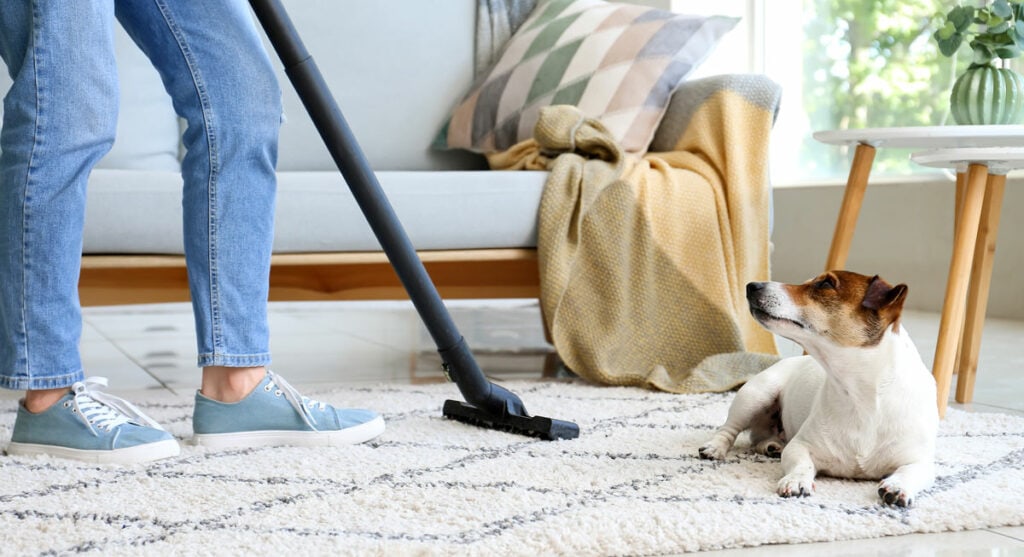
If you have carpets or rugs in your home, vacuuming at least twice a week will help to keep odors at bay. Dust, dirt, dander, and dog hairs get caught in carpet fibers. Unless removed, these cause the carpet to smell musty and unpleasant much more quickly than hard floors or tiles.
Don’t forget to vacuum sofas, carpeted stairs, curtains, and other soft furnishings. Any fabric in the home can harbor doggie smells, although the worst offenders are those your pet has direct contact with.
A powerful pet vacuum is nearly always a good investment, especially if you have a dog that sheds a lot. These have stronger suction and brushes designed to lift dog hair more effectively. Many also come with pet tools for tackling sofas and other awkward locations.
Cordless vacuums are particularly useful for staying ontop of your dog’s hair and dander. Models like the Dyson V15 are expensive, but provide plenty of suction power, a pet tool, and the convenience of not needing a cord.
5. Vacuum and Mop Hard Floors
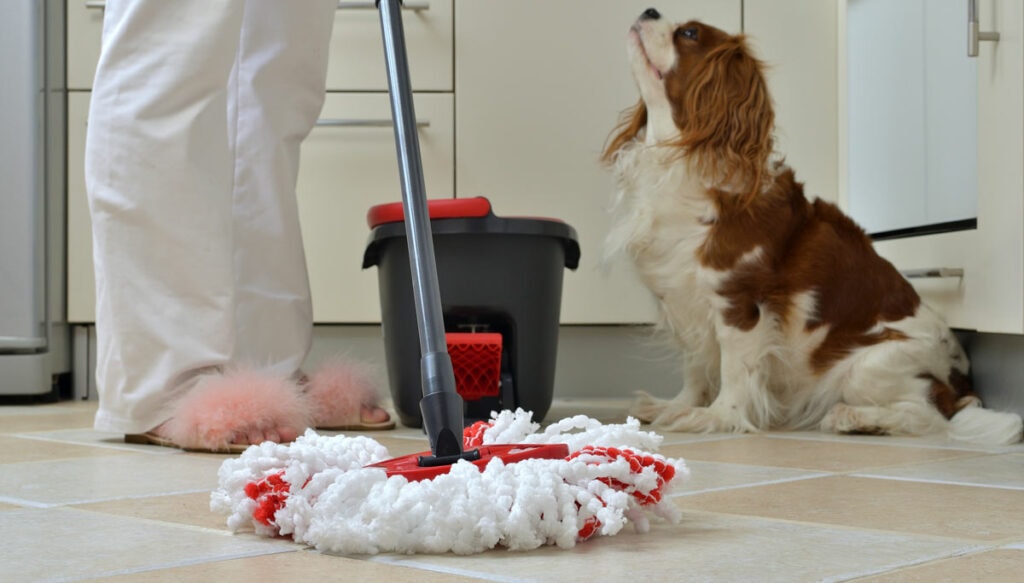
Hardwood floors might not gather hairs and dander like carpets, but they still need to be cleaned. Material can settle into floorboard gaps, become stuck between tiles, and form into stinky ‘dust bunny’ balls.
Vacuuming is the easiest way to prevent odorous material from building up on hard floors. Don’t forget to use the hose extension for dust bunnies that can gather underneath furniture and in hard-to-reach corners.
You should also wash the floors using an absorbent mop. Make sure you only use dog-safe cleaning products though. Even after the floor has dried, traces of the cleaner can be picked up on your dog’s paws and licked off.
Note: Make sure you check which types of cleaners are safe for your floor. Vinegar solutions, for example, shouldn’t be applied to unsealed stone tiles like marble or limestone.
6. Naturally Freshen Up Odorous Carpet Patches With Baking Soda
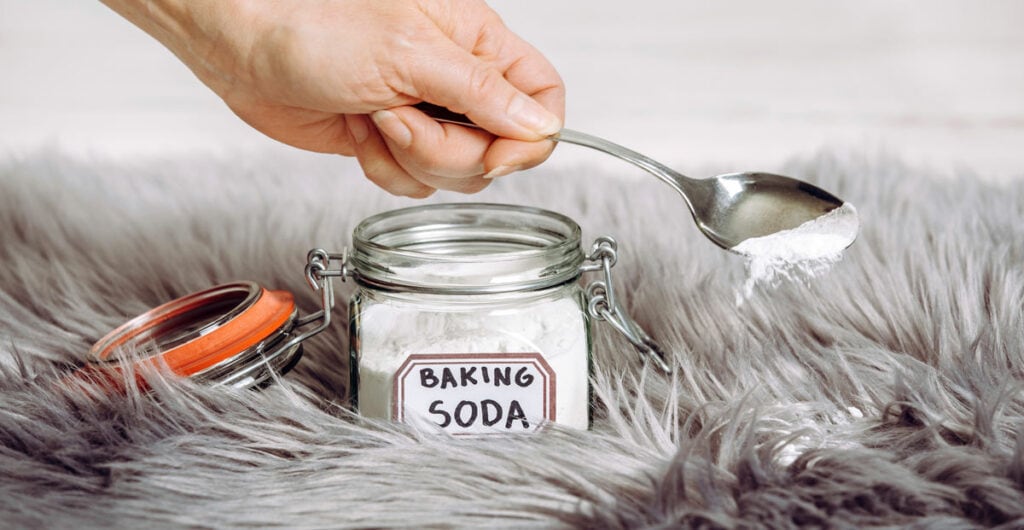
If you have a patch of carpet with a noticeable smell, then vacuuming isn’t going to remove the odor. Instead, you can use baking soda to neutralize the odor.
There have been numerous studies that have shown the efficacy of baking soda as a cleaner and odor absorber, plus it’s safe to use around dogs.
Sprinkle a light coating of baking soda over the patch and let it sit for a couple of hours before vacuuming it up. The baking soda should absorb the odor, leaving behind a fresh-smelling carpet.
7. Thoroughly Clean Your Pet’s Crate
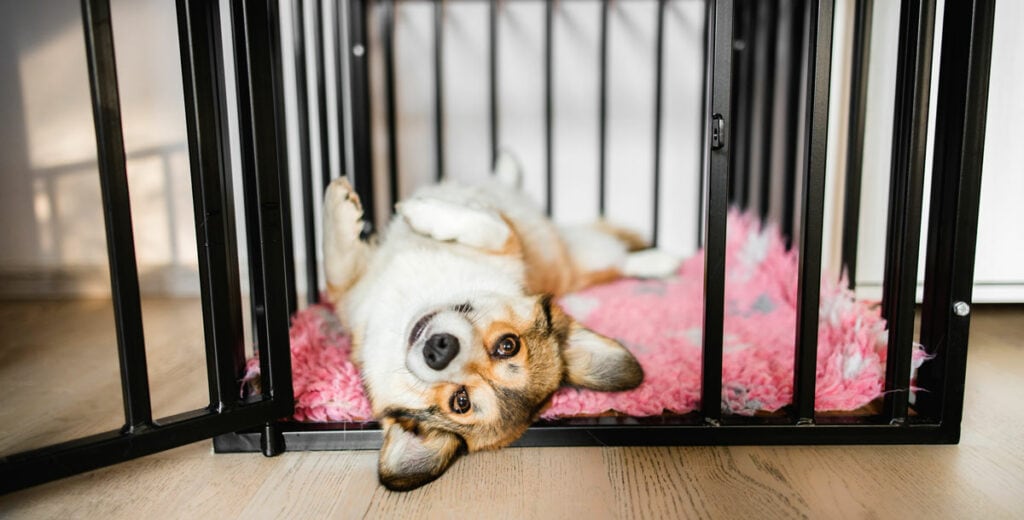
It’s important to regularly clean your dog’s crate – especially if he sleeps in it overnight. Hair and dirt often fall underneath bedding, allowing bacteria to grow and odors to develop.
Make sure you only use a dog-safe and natural cleaning product, then rinse the crate off outside. Remember to lift out the tray and wash this too. After cleaning, ensure all the cleaner has been rinsed off and that the crate is dry before your dog re-enters.
Don’t forget to clean the area around the crate too. This is often a prime place for balls of hair and dust to gather.
8. Eliminate Accidents With Enzymatic Carpet Cleaners
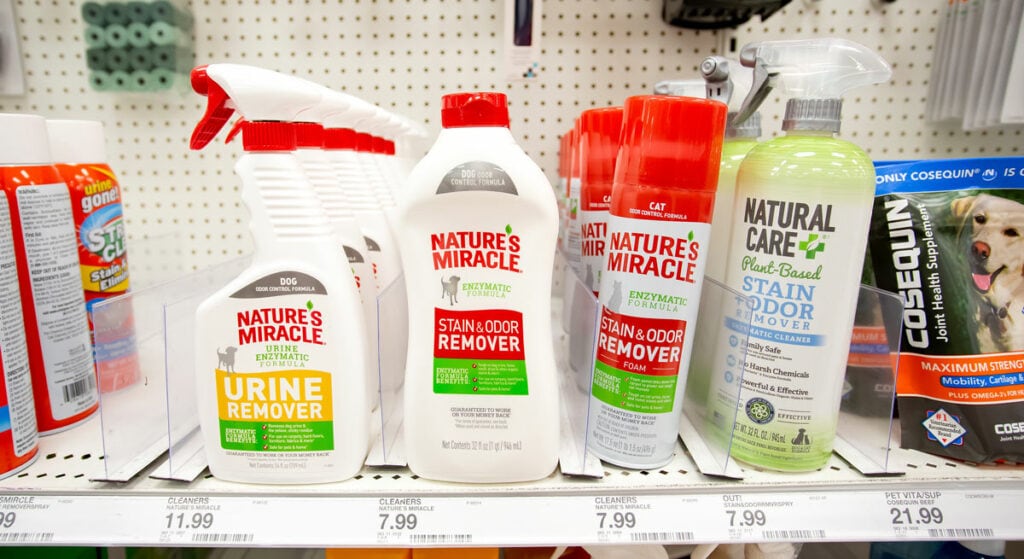
Urine patches on carpets are one of the most common reasons for bad odors in the home. If not cleaned correctly, the odor may gradually get worse. Old urine patches can also encourage your dog to toilet in the same place.
Unfortunately, cleaning with water isn’t enough, as uric acid isn’t water-soluble. You may think you have cleaned the accident, but when the uric acid crystallizes, and the water evaporates, bacteria will begin to form, and concentrated ammonia will be left behind. This emits a pungent, foul odor and results in unsightly brown staining.
To ensure the urine is cleaned properly, make sure you use an enzymatic stain and odor eliminator. These contain enzymes that break down the uric acid and eliminate odors.
For best results, the area should be saturated, and the product should be allowed to work for a while before blotting. Repeat applications can be required for badly affected areas.
If you can smell urine, but you’re not sure where your dog has had their accident, use an ultraviolet stain detection torch to locate the spot. When these are turned on, any urine patches show up in an obvious fluorescent color.

A Homemade Alternative to Enzymatic Cleaners
In an emergency situation, if you don’t have an enzymatic cleaner, you could use a mix of baking soda and vinegar. When used together, these ingredients create fizzy carbonic acid and sodium acetate. Although this won’t be as effective at breaking down the uric acid, it’s a helpful and safe home remedy.
After blotting up as much of the urine as possible, sprinkle baking soda over the wet area. You can then apply a half and half mixture of vinegar and water. If you do this from a spray bottle, you can avoid over-soaking the patch.
Leave the solution on the stain for at least an hour until it has dried out. Before vacuuming the area, it can be helpful to brush the baking soda to make it easier to lift up.
Always test a new solution on a small patch of hidden carpet first though. You don’t want to accidentally stain a large area of carpet!
9. Buy an Air Purifier
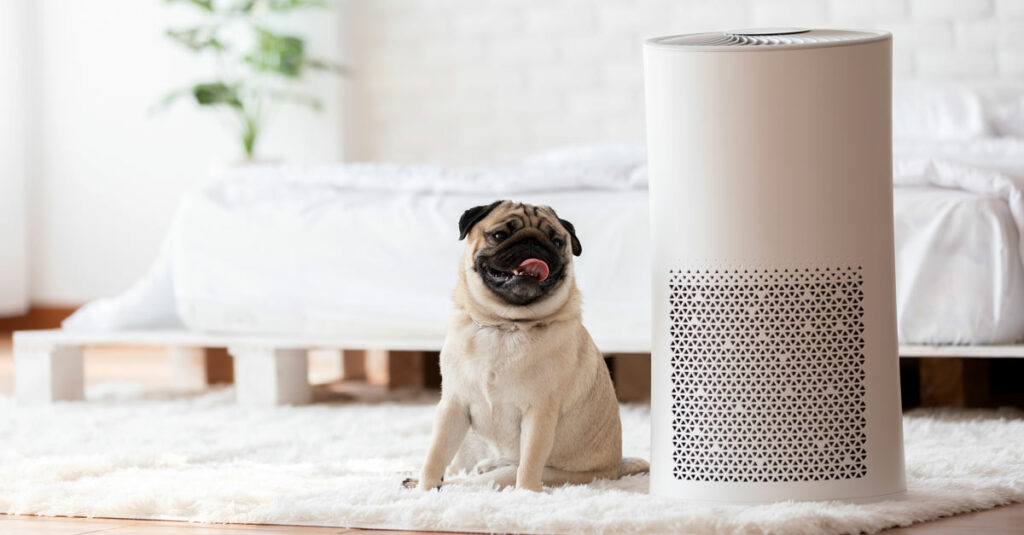
Air purifiers are designed to remove dust, bacteria, and other particles from the air. They can be effective for helping tackle doggy odors too.
When selecting a purifier for a doggy household, make sure you opt for one with an activated charcoal filter. The more common HEPA varieties will help deal with pet dander. They can’t, however, absorb the smaller Volatile Organic Compounds (VOCs), like those responsible for many pet odors.
10. Steam Clean Carpets to Kill Bacteria and Remove Stubborn Odors
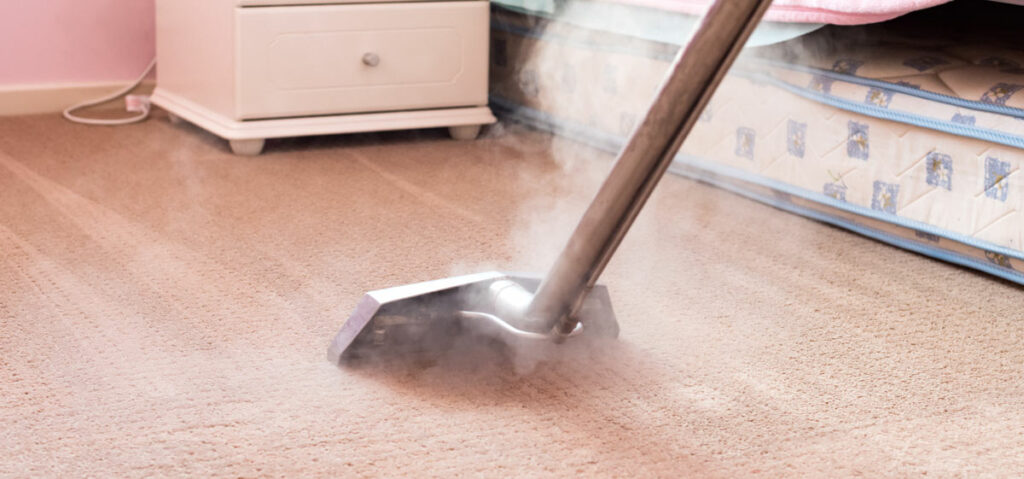
While regular vacuuming is good practice, having your carpets steam cleaned once or twice a year is a dog-safe way to kill remaining bacteria and fungus. It’s also effective as a treatment for home flea infestations, and can reduce the amount of allergens in the environment.
Although it won’t necessarily remove stains, steam cleaning lifts away embedded grime without the use of harsh chemicals. Your entire carpet should be left smelling fresh.
It’s possible to buy your own steam cleaner or hire one, but care should be taken to ensure it’s used properly. It can be easy to leave the carpet overly wet, and this can lead to a further build-up of mold or fungus. Opting to have professionals come to your home can be the most convenient and effective option.
11. Don’t Forget About Walls
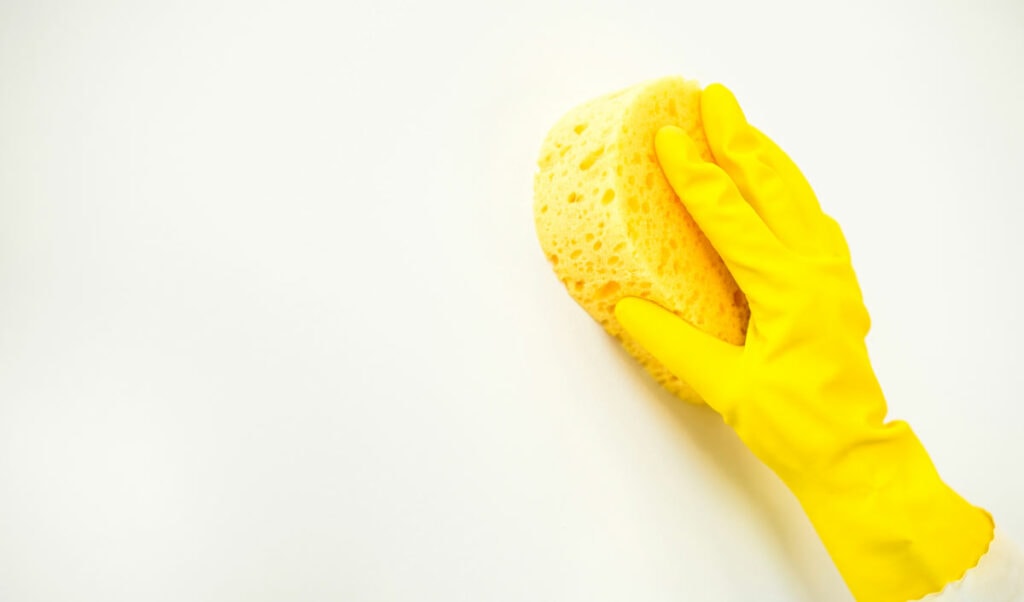
Some dogs like to lie against the walls. Some may even urinate against them before they are fully housetrained! Taking the time to clean skirting boards and walls can remove dirt, bacteria, and other substances that might cause odors.
You may find certain areas need more attention than others. Utility rooms or porches might get sprayed with damp dog hairs when they shake off after a wet walk. If your dog is a drooler, when they shake, the saliva could travel up the walls too.
If your dog has urinated on the walls, they may have saturated them, and no amount of cleaning will completely get rid of the smells. In these instances, the best course of action would be to repaint the area – preferably with an odor-sealant variety.
12. Shampoo Your Carpet Once A Year
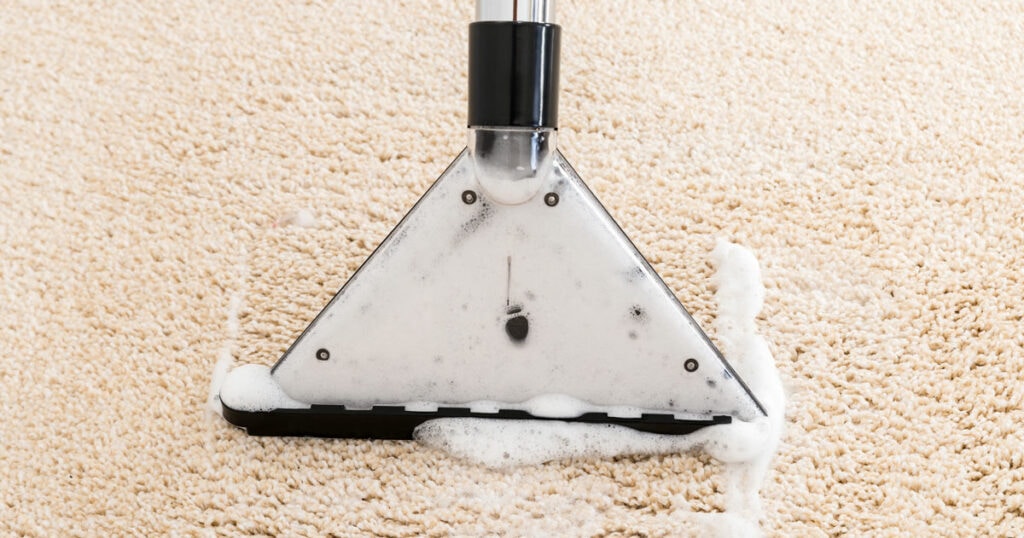
Spot cleaning is effective if you know where your dog has had an accident. But sometimes, the best option for lingering smells is to give your entire carpet a deep clean, as this removes any accidents or smelly patches you may have missed.
For this task, nothing beats a carpet cleaning machine with a specially formulated carpet deodorizer shampoo. Just ensure that your carpet fabric can tolerate this type of cleaning, as some are only suitable for dry cleaning.
This is a big job, as you’ll need to move your furniture and vacuum loose dirt first. It’s also a good idea to pre-treat any noticeable stains with a stain remover, before shampooing.
Once the carpet is ready to be shampooed, use a carpet shampooer to wash the carpet while applying the cleaner. You should then run the shampooer again using cold water to rinse the detergent. Finally, air out the room to allow the carpet to dry as quickly as possible. This can take up to 24 hours, so plan the best time to clean in advance.
13. Groom Your Dog Regularly
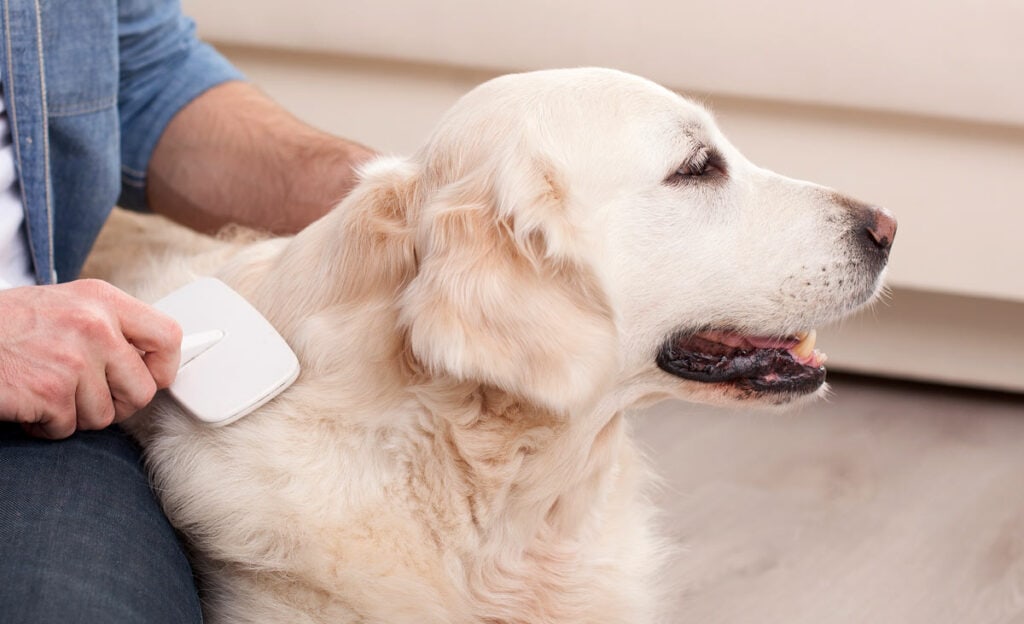
Keeping your doing clean and maintaining coat health is essential for reducing odors in the home.
The most important task is to regularly brush your dog with a brush that’s suitable for their coat type. Brushing removes dead hair, spreads healthy oils, and removes dirt build-up before it can cause matting. This isn’t just important for your dog’s wellbeing but can reduce the amount of loose hair and dirt that’s dropped around your home.
Bathing with a dog-friendly mild shampoo can also reduce odors. However, it’s important not to over bathe your dog. Bathing strips healthy oils from the skin and can cause skin dryness, so you should typically only bathe your dog once every 4-8 weeks. Of course, if they roll in something smelly, you might have no choice but to give them a bath.
Tip: Never use human shampoos or human conditioners on your pup. These are not pH-balanced for canine skin. Many human shampoos also contain chemicals that are not safe for dogs.
14. Add Apple Cider Vinegar to Your Laundry

For an extra freshness boost, consider adding a pinch of apple cider vinegar (or white vinegar) to your laundry detergent.
Apple cider vinegar is non-toxic, but acts as an anti-bacterial agent when washing clothing. This means it can kill germs on your dog’s sheets, bedding, and other fabrics.
You don’t need to add much to your laundry. A 1/2 cup of apple cider vinegar into your machine’s detergent compartment is plenty.
15. Regularly Clean Your Vacuum’s Filters
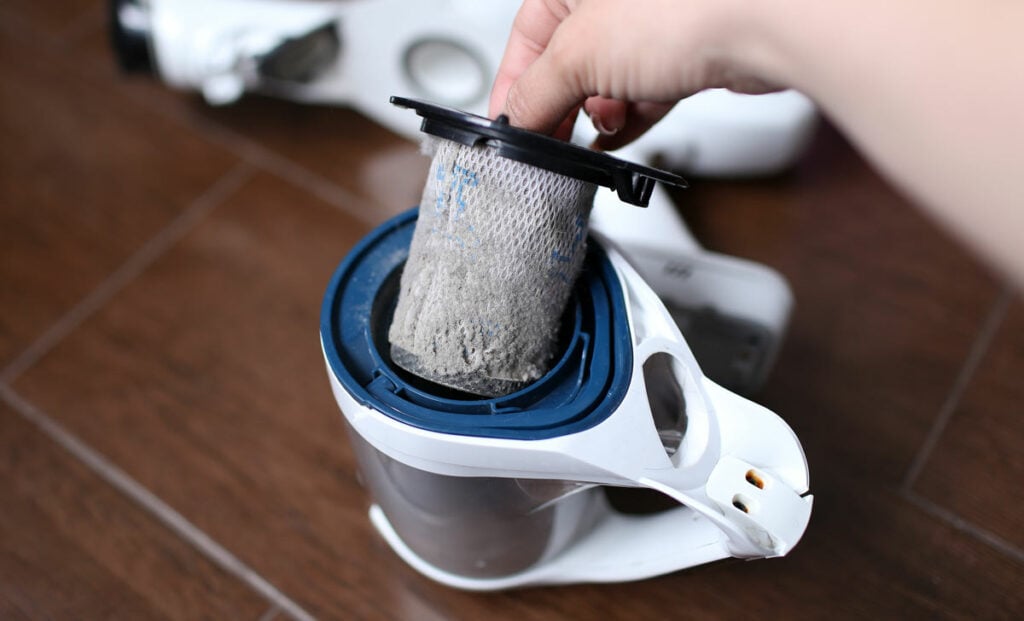
The filter in your vacuum stops pet dander and other small particles from escaping back into the air. Over time, these small particles build up on the filter, which can cause clogging
A clogged filter reduces suction power and makes the vacuum less effective. These particles can also start to become a home for odorous bacteria. This is why vacuums sometimes emit a nasty pet odor when in use – the exact opposite of what you want when cleaning!
To prevent this, make sure you regularly clean your vacuum filter. Most filters should be cleaned once a month, but you may need to wash yours more frequently if you have multiple dogs in the home.
Make sure you follow the manufacturer’s instructions when cleaning your filter, as the process varies. Always ensure the filter is completely dry before using it again.
Tip: Some pet vacuums come with an activated charcoal filter. This helps prevent dog odors when vacuuming.
What Causes a “Doggie” Smell in a House?
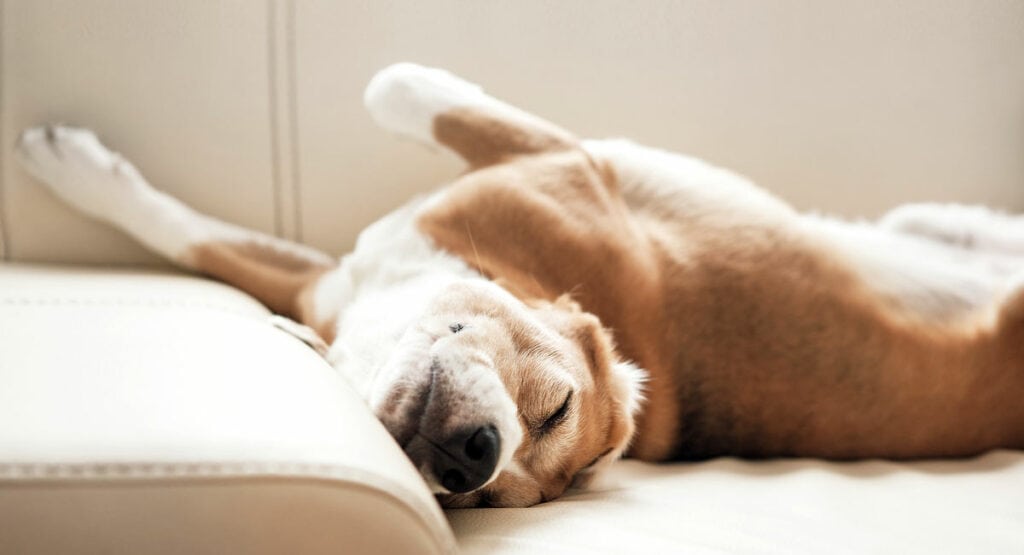
A lingering doggie smell can either come from the dog themselves, or from odors embedded into soft furnishings and flooring. In many cases, it’ll be a combination of the two.
Why Dogs Have a Distinct Smell
All dogs have a natural odor that’s secreted from glands across their body. The bulk of these are in paws, around the anus, and in footpads. Many owners comment on how their dog’s paws smell like Fritos!
Some dogs have stronger odors than others though. These include:
- Breeds with oily coats. Oily coats often have a stronger scent. Coats with water-resistant properties, like those found on a Labrador Retriever, are prime examples.
- Breeds that drool more than others. Dogs that are prone to excessive drooling can be smellier, particularly around their mouth, neck and chest.
- Dogs with health conditions. Some health conditions, like allergies or skin infections, can cause your dog to be more smelly than normal. It’s important to seek veterinary advice if you notice any changes to your dog’s skin, behavior, or odors.
- Dogs who are dirt magnets. Dogs who love outdoor adventures, swimming, or rolling in smelly things are all likely to be whiffier.
Even the cleanest dogs eventually start to smell as oil and dirt builds up in their coat. Having a regular grooming regime and giving your dog occasional baths with a high-quality odor control shampoo can prevent this.
Why Furniture and Floors Smell of Dogs
While it’s often easy to notice when your dog smells bad, odors can also become embedded in soft furnishings, upholstery (such as your couch fabric) and flooring around the house. This is due to drool, pet hair, dander, coat oils and saliva becoming absorbed into fabrics and crevices.
These odors are often more difficult to pinpoint and remove. Over time, they start to permeate the home, which is why doggie smells can remain even after bathing your dog.
Of course, if you have a puppy, elderly dog, or a pet who isn’t house trained, indoor accidents are also a major source of bad odors. Urine can be tricky to remove, and if you don’t tackle the clean up thoroughly, overpowering smells can begin to emanate from those spots. These smells also encourage your dog to return to the same spot.
Frequently Asked Questions
A dog smell can remain in a house for many months. In some cases, the odor could last for years if the source isn’t properly cleaned.
Baking soda is an alkaline material. As acidic materials cause most odors, baking soda reacts with the substance, causing the odors to be neutralized. Baking soda itself doesn’t have an odor, which makes it particularly useful for cleaning the home.
Summary
While doggie odors are unavoidable in a home with dogs, there are many ways to make them less noticeable. The 15 tips in this article are a great place to start when clearing up the mess from your furry friend.
Of course, make sure that all the cleaning products you use are safe for dogs. Many chemical cleaners are toxic to dogs, so look for natural and safe alternatives when removing smells in your home.
Do you have any questions about removing a dog smell in the house? Or do you have a tip that we haven’t included? Let us know in the comments section! For more tips for your home, read our guide to dog-proofing a house.
